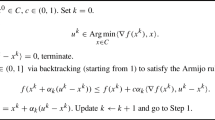Abstract
We consider the problem of reconstructing two-dimensional convex binary matrices from their row and column sums with adjacent ones. Instead of requiring the ones to occur consecutively in each row and column, we maximize the number of adjacent ones. We reformulate the problem by using integer programming and we develop approximate solutions based on linearization and convexification techniques.
Similar content being viewed by others
References
Balázs, P.: A framework for generating some discrete sets with disjoint components by using uniform distributions. Discrete Appl. Math. 406, 15–23 (2008)
Balázs, P.: Reconstruction of canonical hv-convex discrete sets from horizontal and vertical projections. In: 13th International Workshop on Combinatorial Image Analysis. Lecture Notes in Computer Science, vol. 5852, pp. 280–288. Playa del Carmen, Mexico (2009)
Balázs, P.: A benchmark set for the reconstructin of hv-convex discrete sets. Discrete Appl. Math. 157, 3447–3456 (2009)
Balázs, P.: Benchmark collections for the reconstruction of hv-convex discret sets. http://www.inf.u-szeged.hu/pbalazs/benchmark/benchmark.html (2010). Accessed 11 Sept 2009
Billionnet, A., Elloumi, S., Lambert, A.: Extending the QCR method to general mixed-integer programs. Math. Program. 131, 381–401 (2012)
Billionnet, A., Elloumi, S., Plateau, M.-C.: Improving the performance of standard solvers for quadratic 0-1 programs by a tight convex reformulation: the QCR method. Discrete Appl. Math. 25, 1185–1197 (2007)
Chang, S.: The reconstruction of binary patterns from their projections. Commun. ACM 14, 21–25 (1971)
Chrobak, M., Dürr, C.: Reconstructing hv-convex polyominoes from orthogonal projections. Inf. Process. Lett. 69, 283–289 (1999)
Dahl, G., Flatberg, T.: Optimization and reconstruction of hv-convex (0, 1)-matrices. Discrete Appl. Math. 151, 93–105 (2005)
Del Lungo, A.: Polyominoes defined by two vectors. Theor. Comp. Sci. 127, 187–198 (1994)
Flajolet, P., Zimmermann, P., Van Custem, B.: A calculs for the random generation of labelled combinatorial structures. Theor. Comp. Sci. 132, 1–35 (1994)
Fortet, R.: Applications de l’algèbre de boole en recherche opérationnelle. RAIRO Rech. Opér. 4, 5–36 (1959)
Gale, D.: A theorem on flows in networks. Discrete Math. 187, 1073–1082 (1957)
Glover, F.: Improved linear integer programming formulation of non linear integer problems. Manage. Sci. 22, 445–460 (1975)
Haber, R.M.: Term Rank of 0,1 Matrices. Rendiconti del Seminario Matematico della Università di Padova, vol. 30, pp. 24–51 (1960)
Hammer, P.L., Rubin, A.A.: Some remarks on quadratic programming with 0-1 variables. RAIRO Rech. Opér. 3, 67–79 (1970)
Herman, G.T., Kuba, A.: Discrete Tomography: Foundations, Algorithms and Applications. Birkhauser (1999)
Irving, R.W., Jerrum, M.R.: Three-dimensional statistical data security problems. SIAM J. Comput 23, 170–184 (1994)
Jarray, F., Costa, M.-C., Picouleau, C.: Approximating hv-convex binary matrices and images from discrete projections. In: 14th Discrete Geometry for Computer Imagery. LNCS, vol. 4992, pp. 413–422. Lyon, France (2008)
Kuba, A.: The reconstruction of two-directionally connected binary patterns from their two orthogonal projections. Comput. Vis. Graph. Image Process. 27(3), 249–265 (1984)
Nemhauser, G.L., Wolsey, L.A.: Integer and Combinatorial Optimization. New York (1988)
Ourmazd, A., Kisielowski, C., Schwander, P., Baumann, F.H., Seibt, M., Kim, Y.: An approach to quantitative high-resolution transmission electron microscopy of crystalline materials. Ultramicroscopy 58, 131–155 (1995)
Pinzani, R., Barcucci, E., Del Lungo, A., Nivat, M.: Reconstructing convex polyominoes from horizontal and vertical projections. Theor. Comp. Sci. 155(2), 321–347 (1996)
Prause, G.P.M., Onnasch, D.G.W.: Binary reconstruction of the heart chambers from biplane angiographic image sequence. IEEE Trans. Med. Imag. 15, 532–559 (1996)
Ryser, H.: Combinatorial properties of matrices of zeros and ones. Can. J. Math. 9, 371–377 (1957)
Shliferstein, A.R., Chien, Y.T.: Switching components and the ambiguity problem in the reconstruction of pictures from their projections. Pattern Recogn. 10, 327–340 (1978)
Wang, Y.: Characterization of binary patterns and their projections. IEEE Trans. Comput. 24, 1032–1035 (1975)
Woeginger, G.: The reconstruction of polyominoes from their orthogonal projections. Inf. Process. Lett. 77, 225–229 (2001)
Author information
Authors and Affiliations
Corresponding author
Rights and permissions
About this article
Cite this article
Billionnet, A., Jarray, F., Tlig, G. et al. Reconstructing Convex Matrices by Integer Programming Approaches. J Math Model Algor 12, 329–343 (2013). https://doi.org/10.1007/s10852-012-9193-5
Received:
Accepted:
Published:
Issue Date:
DOI: https://doi.org/10.1007/s10852-012-9193-5




